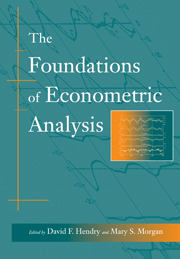Book contents
- Frontmatter
- Contents
- Preface
- Acknowledgements
- Introduction
- Bibliography
- I The Emerging Role of Econometrics in Economics
- II Early Time-Series Analysis
- 6 On the Study of Periodic Commercial Fluctuations (Read to the British Association in 1862, and in Investigations in Currency and Finance, Macmillan, 1884, pp. 3–10 and plates)
- 7 Correlation of the Marriage-Rate with Trade (Journal of the Royal Statistical Society, vol. 64, 1901, pp. 485–92)
- 8 The Correlation of Economic Statistics (Journal of the American Statistical Association, vol. 12, 1910, pp. 289–94, 306–17 (cut))
- 9 Why do we sometimes get Nonsense Correlations between Time-Series? (Journal of the Royal Statistical Society, vol. 89, 1926, pp. 2–9, 30–41)
- 10 On a Method of Investigating Periodicities in Disturbed Series, with Special Reference to Wolfer's Sunspot Numbers (Philosophical Transactions of the Royal Society of London, A, vol. 226, 1927, pp. 267–73)
- 11 A Random-Difference Series for Use in the Analysis of Time Series (Journal of the American Statistical Association, vol. 29,934, pp. 11–24 (data cut))
- 12 Calculation and Elimination of Seasonal Fluctuations [Berechnung und Ausschaltung von Saisonschwankungen] (Julius Springer, Vienna, 1936, chap. 1)
- 13 Morgenstern on the Methodology of Economic Forecasting (Journal of Political Economy, vol. 37, 1929, pp. 312–17, 320–3, 326–37 (cut))
- III Applied Econometrics and the Identification Problem
- IV The Evolution of Statistical Thinking in Econometrics
- V Dynamic Models
- VI The Tinbergen Debate
- VII Structure and Simultaneity
- VIII The Probabilistic Revolution
- IX Exogeneity
- Index
12 - Calculation and Elimination of Seasonal Fluctuations [Berechnung und Ausschaltung von Saisonschwankungen] (Julius Springer, Vienna, 1936, chap. 1)
Published online by Cambridge University Press: 05 June 2012
- Frontmatter
- Contents
- Preface
- Acknowledgements
- Introduction
- Bibliography
- I The Emerging Role of Econometrics in Economics
- II Early Time-Series Analysis
- 6 On the Study of Periodic Commercial Fluctuations (Read to the British Association in 1862, and in Investigations in Currency and Finance, Macmillan, 1884, pp. 3–10 and plates)
- 7 Correlation of the Marriage-Rate with Trade (Journal of the Royal Statistical Society, vol. 64, 1901, pp. 485–92)
- 8 The Correlation of Economic Statistics (Journal of the American Statistical Association, vol. 12, 1910, pp. 289–94, 306–17 (cut))
- 9 Why do we sometimes get Nonsense Correlations between Time-Series? (Journal of the Royal Statistical Society, vol. 89, 1926, pp. 2–9, 30–41)
- 10 On a Method of Investigating Periodicities in Disturbed Series, with Special Reference to Wolfer's Sunspot Numbers (Philosophical Transactions of the Royal Society of London, A, vol. 226, 1927, pp. 267–73)
- 11 A Random-Difference Series for Use in the Analysis of Time Series (Journal of the American Statistical Association, vol. 29,934, pp. 11–24 (data cut))
- 12 Calculation and Elimination of Seasonal Fluctuations [Berechnung und Ausschaltung von Saisonschwankungen] (Julius Springer, Vienna, 1936, chap. 1)
- 13 Morgenstern on the Methodology of Economic Forecasting (Journal of Political Economy, vol. 37, 1929, pp. 312–17, 320–3, 326–37 (cut))
- III Applied Econometrics and the Identification Problem
- IV The Evolution of Statistical Thinking in Econometrics
- V Dynamic Models
- VI The Tinbergen Debate
- VII Structure and Simultaneity
- VIII The Probabilistic Revolution
- IX Exogeneity
- Index
Summary
General Remarks on the Analysis of Time Series
The current assumption made in business cycle research is that a time series is composed from four component motions, which are defined in the following manner:
a) the trend: the general tendency of development over long time periods which reproduces the main course of the time series;
b) the cyclical fluctuations: these are wave-shaped movements that are superimposed on the trend:
c) the seasonal fluctuations: these are regular movements recurring yearly at the same time points:
d) the irregular fluctuations: these are composed chiefly of smaller fluctuations often appearing to have a chance character.
The decomposition of the time series into the above four components corresponds to the notion that the time series is to be considered as the effect of four groups of causes. The trend depends on secular causes, such as population increase, industrial and cultural development, improvement in the means of transport, and so on. The cyclical fluctuations originate in changes in economic activity and conditions of profitability. The seasonal fluctuations are brought about through the influence of the weather, or by social institutions, that, calendar like, fixed and yearly, regularly bring about similar fluctuations. Finally the irregular fluctuations arise according to causes which fall under none of the other three named groups.
The task of the analysis is the quantitative determination of the separate components corresponding to the above groups of causes.
- Type
- Chapter
- Information
- The Foundations of Econometric Analysis , pp. 175 - 179Publisher: Cambridge University PressPrint publication year: 1995

